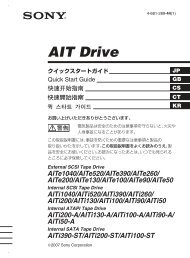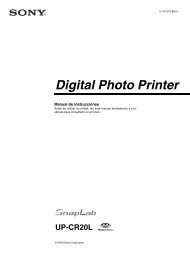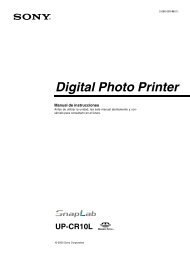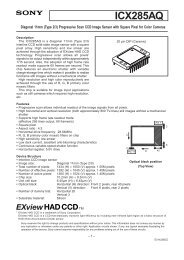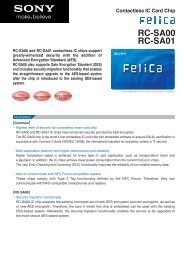PDF [4833KB] - Sony
PDF [4833KB] - Sony
PDF [4833KB] - Sony
Create successful ePaper yourself
Turn your PDF publications into a flip-book with our unique Google optimized e-Paper software.
Image sensors Display components Memory Stick<br />
Tapping the strengths of CCD and CMOS<br />
image sensors<br />
<strong>Sony</strong> has the leading share of the global market<br />
for CCDs. This key component not only<br />
supports our lineup of mobile products, such<br />
as digital still cameras and video cameras, but<br />
also contributes to profitability through sales<br />
to external customers. In July 2003, <strong>Sony</strong> was<br />
the first company to develop a CCD for consumer<br />
digital still cameras that has a four-color<br />
filter: red, green, blue and emerald. This breakthrough<br />
will be leveraged to differentiate <strong>Sony</strong><br />
cameras from those of its competitors. We will<br />
also strive to make the CCDs smaller, while<br />
simultaneously enhancing picture quality.<br />
<strong>Sony</strong> is also developing CMOS image sensors.<br />
This component offers the advantages of low<br />
power consumption, faster processing speed,<br />
and the ability to place peripheral circuitry on a<br />
single chip. Traditionally, picture quality from<br />
CMOS image sensors has been thought to be<br />
inferior to that of CCDs. <strong>Sony</strong> has almost<br />
completed work on a CMOS image sensor that<br />
produces a higher-quality picture. This is being<br />
accomplished by applying manufacturing knowhow<br />
that was gained from the production of<br />
CCDs and using sophisticated equipment for<br />
the MOS process. <strong>Sony</strong> will continue its CMOS<br />
image sensor development program with the<br />
goal of expanding this business.<br />
Joint venture with Samsung to massproduce<br />
next generation LCD panels<br />
Demand for flat panel displays is increasing<br />
rapidly, with applications for this technology<br />
ranging from cellular phones, digital still<br />
cameras, televisions, PC monitors and rearprojection<br />
televisions. To ensure a stable<br />
supply of LCD panels to meet the expected<br />
growth in demand for large screen LCD<br />
televisions, <strong>Sony</strong> and Samsung Electronics Co.,<br />
Ltd. established S-LCD Corporation. This joint<br />
venture will develop and manufacture seventhgeneration<br />
(1,870mm x 2,200mm glass substrate)<br />
amorphous silicon TFT LCD panels to be<br />
used in large screen televisions. Full scale production<br />
is scheduled to begin in the fiscal year<br />
ending March 31, 2006.<br />
A rear-projection television with an ultra<br />
high-resolution LCD<br />
As LCD panels with increasingly high-resolution<br />
become available, even small devices will have<br />
the ability to display ultra-fine images. <strong>Sony</strong> has<br />
developed a display device called the SXRD<br />
(Silicon X-tal Reflective Display) that can produce<br />
high-resolution, high-contrast images with<br />
cinematic quality. <strong>Sony</strong> will use SXRD to produce<br />
front projectors and rear-projection televisions<br />
that will have a far better picture quality<br />
than those currently available.<br />
Meeting the new demand for increasingly<br />
widespread music distribution and highresolution<br />
video recording<br />
Since its debut six years ago, the Memory Stick<br />
business has continued to grow rapidly, fueled<br />
by the growth of the digital still camera market.<br />
As a result, cumulative shipments have surpassed<br />
70 million units. <strong>Sony</strong> and more than<br />
500 other companies that support this technology<br />
are developing new markets for Memory<br />
Stick. Music and e-book distribution services are<br />
two applications that will be added during the<br />
fiscal year ending March 31, 2005, with highresolution<br />
video recording as another potential<br />
addition. To ensure ease of use for a broad<br />
range of applications, all Memory Stick media is<br />
equipped with copyright protection technology<br />
and high-speed data transfer capability. <strong>Sony</strong><br />
plans to launch higher-capacity media with the<br />
introduction of a 2GB version in 2004 and a<br />
4GB version in 2005.<br />
Memory Stick PRO<br />
Memory Stick PRO Duo<br />
CCD with a four-color filter<br />
Practical application for OEL displays<br />
OEL displays can reproduce highly vivid colors<br />
with the fast response required for smooth<br />
video playback. Backlighting is not required<br />
because the panel is self-luminescent, producing<br />
three colors: red, green and blue. This<br />
allows for panels to be extremely slim. <strong>Sony</strong> is<br />
working toward the practical application of the<br />
OEL display to mobile devices.<br />
Memory Stick<br />
Memory Stick Duo<br />
LCD display component, “4K SXRD”<br />
20


![PDF [4833KB] - Sony](https://img.yumpu.com/26420643/22/500x640/pdf-4833kb-sony.jpg)
